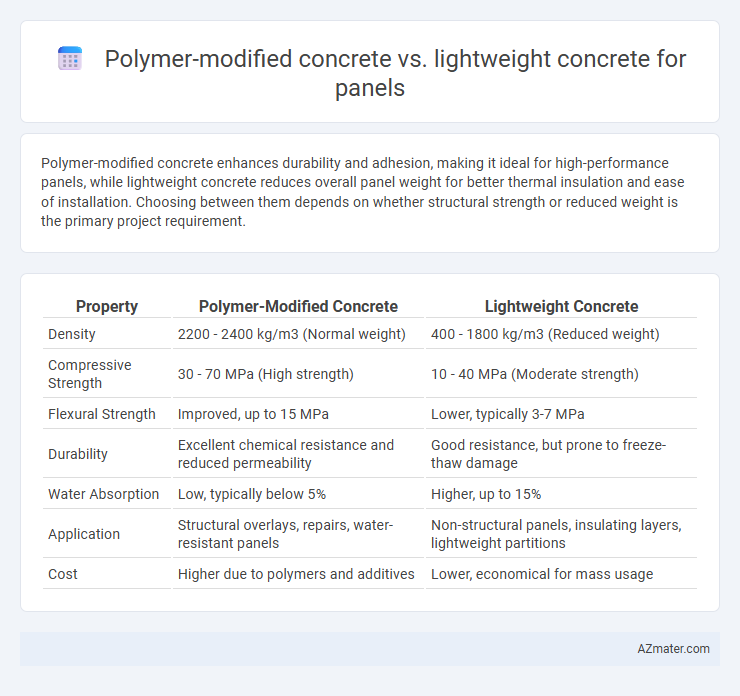Polymer-modified concrete enhances durability and adhesion, making it ideal for high-performance panels, while lightweight concrete reduces overall panel weight for better thermal insulation and ease of installation. Choosing between them depends on whether structural strength or reduced weight is the primary project requirement.
Table of Comparison
| Property | Polymer-Modified Concrete | Lightweight Concrete |
|---|---|---|
| Density | 2200 - 2400 kg/m3 (Normal weight) | 400 - 1800 kg/m3 (Reduced weight) |
| Compressive Strength | 30 - 70 MPa (High strength) | 10 - 40 MPa (Moderate strength) |
| Flexural Strength | Improved, up to 15 MPa | Lower, typically 3-7 MPa |
| Durability | Excellent chemical resistance and reduced permeability | Good resistance, but prone to freeze-thaw damage |
| Water Absorption | Low, typically below 5% | Higher, up to 15% |
| Application | Structural overlays, repairs, water-resistant panels | Non-structural panels, insulating layers, lightweight partitions |
| Cost | Higher due to polymers and additives | Lower, economical for mass usage |
Introduction to Polymer-Modified Concrete and Lightweight Concrete
Polymer-modified concrete incorporates synthetic polymers to enhance the bonding, flexibility, and durability of traditional concrete, making it ideal for panels that require superior adhesion and resistance to cracking. Lightweight concrete, characterized by its reduced density due to lightweight aggregates such as expanded clay or shale, offers improved thermal insulation and ease of handling without sacrificing structural integrity. Both materials serve distinct purposes in panel construction, with polymer-modified concrete excelling in strength and durability, while lightweight concrete provides benefits in weight reduction and energy efficiency.
Composition and Material Properties
Polymer-modified concrete incorporates polymers such as styrene-butadiene or acrylics to enhance adhesion, tensile strength, and durability, making it highly resistant to water and chemical ingress. Lightweight concrete, often made with expanded clay, shale, or pumice aggregates, features reduced density and improved thermal insulation due to the introduction of air voids within the matrix. The polymer additives in polymer-modified concrete improve flexibility and impact resistance, whereas lightweight concrete excels in weight reduction and thermal performance, ideal for panel applications requiring energy efficiency and structural load minimization.
Manufacturing Process Comparison
Polymer-modified concrete (PMC) manufacturing involves integrating polymers such as styrene-butadiene or acrylics into traditional concrete mixes to enhance bonding and durability, requiring precise polymer dosage and thorough mixing to ensure uniform dispersion. Lightweight concrete production incorporates lightweight aggregates like expanded clay, shale, or pumice to reduce density, demanding careful aggregate selection and controlled water-cement ratios to achieve desired strength and thermal properties. The key manufacturing difference lies in polymer integration for PMC, which modifies the matrix at a molecular level, whereas lightweight concrete focuses on aggregate substitution to alter material density and insulation characteristics.
Structural Performance and Strength
Polymer-modified concrete exhibits superior tensile strength and enhanced durability compared to lightweight concrete, making it ideal for structural panels requiring high load-bearing capacity. Lightweight concrete offers reduced density and improved thermal insulation but generally has lower compressive strength, which may limit its use in load-critical applications. Optimizing panel design involves balancing polymer modification for strength with lightweight aggregates to achieve desired performance characteristics.
Panel Weight and Ease of Installation
Polymer-modified concrete panels offer enhanced strength with moderate weight, improving durability without significantly increasing installation complexity. Lightweight concrete panels reduce overall panel weight, facilitating easier handling and faster installation but may require additional reinforcement for strength. Choosing between the two depends on balancing structural performance with installation efficiency in construction projects.
Durability and Longevity
Polymer-modified concrete offers enhanced durability due to its improved resistance to chemical attacks, abrasion, and water penetration, making it ideal for long-lasting panels in harsh environments. Lightweight concrete, while beneficial for reducing structural load and improving thermal insulation, generally exhibits lower compressive strength and higher porosity, which can compromise durability under severe weather conditions. For panel applications requiring extended longevity and resistance to environmental stressors, polymer-modified concrete provides superior performance compared to lightweight concrete.
Thermal and Acoustic Insulation
Polymer-modified concrete exhibits enhanced thermal insulation properties due to its reduced thermal conductivity and improved density, making it effective for energy-efficient panels. Lightweight concrete offers superior acoustic insulation as its porous structure absorbs sound waves, reducing noise transmission in building panels. Both materials contribute to improved panel performance, with polymer modification optimizing thermal resistance and lightweight aggregates enhancing soundproofing capabilities.
Cost Analysis and Economic Factors
Polymer-modified concrete (PMC) typically incurs higher initial costs due to the price of synthetic polymers, but offers enhanced durability and reduced maintenance expenses, leading to lower lifecycle costs in panel applications. Lightweight concrete, although generally less expensive upfront due to lower density aggregates, may require additional structural support, increasing overall project costs. Evaluating economic factors, PMC often proves more cost-effective over time for panels exposed to harsh environments, while lightweight concrete benefits budget-sensitive projects prioritizing reduced dead load.
Environmental Impact and Sustainability
Polymer-modified concrete enhances durability and reduces permeability, leading to longer-lasting panels with less frequent repairs, thereby lowering environmental impact through resource conservation. Lightweight concrete reduces structural load and material consumption, improving energy efficiency in transportation and construction while offering better thermal insulation, which decreases building energy use. Both materials contribute to sustainability, with polymer-modified concrete optimizing lifecycle performance and lightweight concrete minimizing embodied carbon and enhancing energy efficiency.
Application Suitability for Building Panels
Polymer-modified concrete offers enhanced durability, adhesion, and resistance to chemicals, making it highly suitable for high-performance building panels in harsh environments. Lightweight concrete provides excellent thermal insulation and reduced structural load, ideal for exterior and non-load-bearing panels where energy efficiency is prioritized. Selection between these materials depends on project-specific requirements such as mechanical strength, weight constraints, and environmental exposure.

Infographic: Polymer-modified concrete vs Lightweight concrete for Panel
 azmater.com
azmater.com